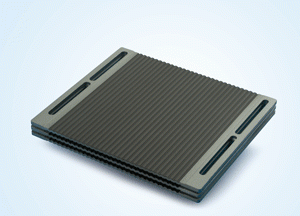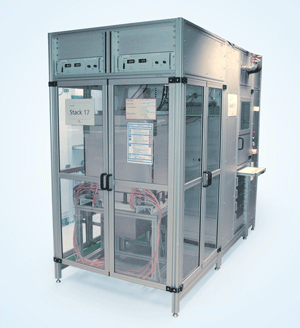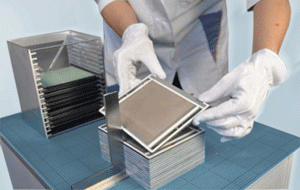Solid oxide fuel cells project, SOFC20, uses world’s largest Powder Metallurgy interconnects
What is a SOFC?
A Solid Oxide Fuel Cell, or SOFC for short, is used at operating temperatures of between 650 and 1000°C. In an ESC SOFC (Electrolyte Supported Cell), the electrolyte not only conducts the oxygen ions but also ensures the mechanical stability of the cell.
Unlike other types of fuel cell, the SOFC is not only able to convert hydrogen to water with the help of oxygen, but can also convert CO to CO2. This electrochemical reaction results in the generation of predominantly electrical power from the energy contained in the gases.
The high operating temperature of the SOFC offers a crucial advantage: Hydrogen and CO can be produced within the fuel cell system from natural gas, biogas or other gases containing hydrocarbons, by means of what is known as a shift reaction.
Metallic interconnects connect the anode and cathode of the individual cells electrically and distribute fuel gas and air to the active areas. Several cell layers stacked on top of one another create a cell stack. The SOFC stacks are housed in a hot box which shields the rest of the fuel cell system from the high temperature and contains ducts for fuel gas, air, electric conductors and sensors.
The peripheral components (BoP) provide the stack module with all the requisite media. Among other things, the BoP includes a fuel gas desulfurization unit, all the control systems for fuel gas and air, heat exchangers, fans and an AC inverter to convert the direct current produced by the fuel cell into alternating current.
SOFC20: Initial test with hot box stack module completed successfully
For the SOFC20 project, the Fraunhofer Institute for Ceramic Technologies IKTS designed the hot box with eight fuel cell stacks in series.
The initial test of the newly developed hot box was completed successfully in March 2012. During the test, the stack module achieved a power output of 5.5 kW. Following a further test using simulated natural gas reformate, the stack module will be installed in a specially developed system environment at AVL List GmbH, where it will be tested.
Plansee’s contribution to this project is the world’s largest SOFC interconnects with an integrated protective coating manufactured using powder metallurgy (PM) and with dimensions of 130 x 150 mm. These components connect the individual fuel cells and distribute fuel gas and air in the system. With the MK351, Plansee has developed an interconnect from chromium (Cr), iron (Fe) and yttrium (Y) – known as a CFY alloy – specially for use in combination with electrolyte supported cells made from fully stabilized zirconia. The coefficient of expansion of this chromium-based interconnect is perfectly matched to that of the electrolyte. Unlike proprietary, protected designs, the MK351 interconnect is available to all potential stack manufacturers.
The technology group Schott, as a glass specialist among other things leading in the development and manufacture of complex glass-to-metal seals, and Fraunhofer IKTS is developing new joining materials that are fully compatible with the CFY interconnects in terms of their thermo-mechanical properties. Optimum, long-term sealing using suitable sealing glasses is a prerequisite for achieving high levels of efficiency with the fuel cell stack.
As well as coordinating the overall project, the Fraunhofer IKTS is responsible for the construction of the stack, sealing and characterization of the stacks. The fact that the newly developed MK351 stack design has only a few individual components allows the manufacturing process to be simple and easily automated. Some of the components used are already commercially available or are being manufactured by subcontractors or those involved in the project on a pilot scale.
The insights derived from the tests and characterizations are fed into the development and optimisation of the individual components. The intended high power density of the cells and cyclic stability required for the field of application can only be achieved if the components are perfectly harmonized.
AVL is developing the fuel cell system from gas conditioning right up to the AC inverter and is responsible for integrating the stack module. The company has developed a large number of peripheral components especially for this project, such as the ignition boiler or the residual anode gas recycling blower.
The Jülich Research Center provides particular support for system design and qualification of the desulfurization materials to be used.
SOFC20 project partners
AVL List GmbH
AVL is the world’s largest privately owned company for development, simulation and testing technology of powertrains (hybrid, combustion engines, transmission, electric drive, batteries, fuel cells and software) for mobile as well as stationary applications. AVL consists of 3 business units: Powertrain Engineering, Instrumentation and Test Systems and Advanced Simulation Technologies. AVL employs worldwide 5000 persons and reached a turnover of 825 Mio € in 2011.
Forschungszentrum Jülich
Forschungszentrum Jülich pursues cutting-edge interdisciplinary research addressing pressing issues facing society today while at the same time developing key technologies for tomorrow. Research focuses on the areas of health, energy and environment, and information technology. The cooperation of the researchers at Jülich is characterized by outstanding expertise and infrastructure in physics, materials science, nanotechnology, and supercomputing. With a staff of about 4,700, Jülich – a member of the Helmholtz Association – is one of the largest research centres in Europe.
Fraunhofer IKTS
The Fraunhofer Institute for Ceramic Technologies and Systems IKTS develops state-of-the-art, application-oriented, high-performance ceramic materials; industrial preparation processes using powder technology, wet chemistry, and precursors; and prototype components and systems. With applied fundamental research as our basis and within the framework of R&D projects with partners, we develop concepts for product and process innovations in numerous trendsetting industry sectors. For 20 years Fraunhofer IKTS has been involved in fuel cell research and is now one of the leading research centers in the field of high-temperature fuel cells.
Fraunhofer IKTS is one of 60 institutes of the Fraunhofer-Gesellschaft in Germany. The majority of the 20,000 staff are qualified scientists and engineers, who work with an annual research budget of 1.8 billion euros.
Schott AG
Schott is an international technology group with more than 125 years of experience in the areas of specialty glasses and materials and advanced technologies. SCHOTT ranks number one in the world with many of its products. Its core markets are the household appliance, solar power, pharmaceuticals, electronics, optics, transportation and architecture industries. The business unit Electronic Packaging is a leading developer and manufacturer of hermetic housings and other components for the reliable, long-term protection of sensitive electronics. The core technologies are glass-to-metal and ceramic-to-metal sealing, thermal sensing components as well as a variety of cutting edge specialty glass competences.
Plansee High Performance Materials
Plansee is a world-leading manufacturer of products made from refractory metals and metallic composite materials. The privately owned company has been manufacturing innovative powder-metallurgically processed high-performance materials for over 90 years, and covers the whole production process, right from the raw material to the finished product. The company employs materials experts, product developers and local technical sales staff to provide customers all over the world with all the help and assistance they require.
For further information Contact Nadine Kerber [email protected]
News | Articles | Market reviews | Search directory | Subscribe to e-newsletter








